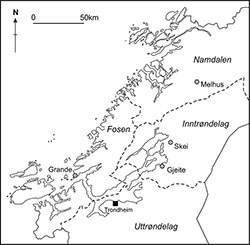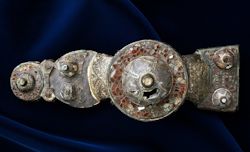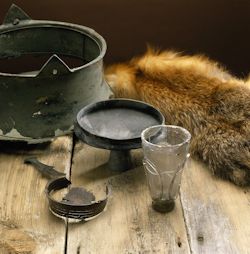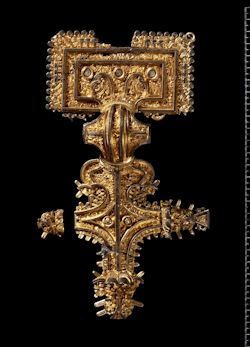

Traditionally, the beginning of the Viking Age has been defined on the basis of the first recorded attack on Lindisfarne in AD 793. Following this assault, the last decade of the 8th century saw an explosion of violence around the shores of Britain and Ireland, including raids throughout the Hebrides in 794, Skye and Iona, Inishmurray and Inishbofin in 795, mainland Scotland in 796, Ulster in 798 and Francia in 799 (Forte et al. 2005, 54). At the earliest, grave goods from these first recorded raids would have ended up in Norse burials in the years around AD 800. However, the nature of initial contact between Scandinavia and Scotland has been much debated, and it has been suggested that these first Viking raiders were drawn to the northern Insular areas as a consequence of direct overseas contact prior to these early recorded raids (e.g. Myhre 1993; Weber 1996). In such discussions, much attention has been paid to the identification of possible reindeer antler in pre-Viking type combs from the Orkney Isles. These combs have been put forward as evidence for a long and largely peaceful initial period of contact before the beginning of the recorded Viking raids, since reindeer in this period were not native to Britain, but widely distributed in Northern Scandinavia (Myhre 1993; Weber 1996.). However, applications of new techniques of raw-material analysis have demonstrated that the arrival of Scandinavian comb-making material in Atlantic Scotland occurred no earlier than the 9th century, and recent research has therefore dismissed this evidence for pre-Viking contact (Ashby 2009; von Holstein et al. 2014). The debate regarding the beginning of the Viking Age has nevertheless led to a more nuanced view of the first contact between Norway and the British Isles, although the first recorded attacks on the British Isles are still widely regarded as the beginning of the Viking Age.
In Trøndelag, four female burials containing Insular artefacts from Grande (Ørlandet), Gjeite (Levanger), Skei (Steinkjer) and Melhus (Overhalla) may be dated to around AD 800, or perhaps slightly earlier (Figure 28). Although their exact date is debated, the early types of brooches found in association with the Insular finds suggest that we are dealing with some of the graves that help to define archaeologically the beginning of the Viking Age (for further discussion, see e.g. Myhre 1993; 1998; Gaut 2001; Stenvik 2001). The bronze mount from Grande was found together with a pair of oval brooches of type R640, usually dated to the late 8th century (Jørgensen 2008, 32-33). The richly furnished cremation burial from Gjeite contained several Insular artefacts, together with two animal-shaped brooches generally assigned to the period immediately prior to the Viking Age (according to unpublished Vitenskapsmuseet catalogue information). One of the brooches showed signs of repair, however, and may have been of some age when put in the burial. A possible date of around AD 800 therefore seems reasonable for this find. An early date is also indicated by the find of a so-called Berdal type 1a brooch with gripping beast ornament from the Skei burial (Figure 29). It has been suggested that such brooches began production in southern Scandinavia during the mid-8th century, based on workshop finds in Ribe, Jutland (Myhre 1993, 186). Stenvik (2001, 75) has suggested that the brooch from Skei may have come from this workshop and was put in the grave by around AD 775. There has, however, been considerable debate regarding the chronology of the culture layers associated with finds of moulds for Berdal brooches in Ribe. Based on excavations carried out during the early 1990s, Feveile and Jensen (2000, 17-18) have reassessed the Ribe dating evidence and argued that the date of the earliest occurrence of Berdal brooches must be adjusted to c. AD 790-800. The Insular grave-furniture from Melhus was found in association with two bowl-shaped brooches of the early type R643, generally attributed to the 8th century. They were accompanied by a particularly elaborate and large fibula brooch (type R649, Figure 30), which may have been produced in the Gotland area of Sweden. Such fibulas are also usually placed in the late Merovingian period, which in Norway is defined as AD c. 600-800. While some of these artefacts may well have been manufactured in the later 8th century, when they were deposited in the grave is, however, another question. Petersen (1907, 19-20) has therefore suggested that the brooches from Melhus were placed in the grave around AD 800.

Together with ten examples from Western Norway, the burials from Grande, Gjeite, Skei and Melhus represent the earliest graves showing contact between the British Isles and Norway. Early graves with Insular finds are traditionally interpreted as an indication of where the first Norse raiders set sail across the North Sea (e.g. Wamers 1998, 52). Some of the early foreign artefacts from Trøndelag can hardly be explained as a result of peaceful interaction. This is particularly illustrated by the reliquary shrine found at Melhus, together with a bronze mount that also appears have originated on an ecclesiastical object. It is unlikely that liturgical implements could be bought as common merchandise for export, and the grave goods from Melhus do seem to represent looted goods from one of the earliest raids on the British Isles. The grave goods from the other burials show a more nuanced picture of the earliest contact between Trøndelag and the British Isles. Insular material from Grande, Skei and Gjeite comprise both clerical and secular objects and seem to reflect a different form of contact than pure, random, plundered loot. The bronze mount from Grande has been identified as part of a horse harness rather than being part of a religious object (Wamers 1985, 93). Many of the Insular artefacts from the women's burials at Skei and Gjeite are serving equipment, for instance larger bronze vessels, ladles, buckets and drinking horns. Several of these artefact types are not generally associated with raiding monasteries and churches. In that connection, it is worth noting the remains of two drinking horn vessels from the Gjeite burial. According to literary sources, such items were considered appropriate gifts to one's allies (Youngs 1989, 74). Alliances formed between Norse chieftains and Irish kings are well recorded in written sources from a slightly later time (see e.g. Corrain 1972, 96; Crawford 1987, 47), and it is possible that the drinking horns from Gjeite are also examples of the same interaction. The number and composition of the early Insular grave finds seem to reflect that both raids and other forms of interaction with the local populations were operating, indicating well-established contact between Trøndelag and the British Isles at an early phase of the Viking Age.

Perhaps not surprisingly, several of the earliest Insular finds from Trøndelag appear on farms where evidence shows that they were leading and powerful centres in the pre-Viking period. Gjeite, Levanger, stands out with a significant corpus of archaeological material for the period around AD 300-800, including gold rings, silver brooches and various bronze vessels imported from the Rhine area (Figure 31). The richness of the farm may be explained by its strategic position. It lies by a natural harbour where communication lines from east, north and south meet, and a trading connection between the Levanger area and the inland areas of central Sweden may have been of particular importance. The wider archaeological evidence suggests that this trading contact may have already been established during the migration period (AD 400-600). Trade and exchange taking place in the Levanger area during the Viking period may well have been administered and controlled by a chieftain based at Gjeite (Herje 1989, 94). The cemetery at Skei borders the farm of Dalem, where some of Norway's richest grave-finds of early Iron Age date (AD 200-600) were discovered in the 1870s (Figure 32). Stenvik (2001, 76) has proposed that Skei and Dalem once formed a single unit, representing an undocumented chieftain centre. This is supported by the presence within the cemetery of a distinctive tunanlegg (court site) of at least nine buildings radiating out around a central courtyard. Although their exact purpose is debated, they appear to have served both administrative and military functions (Stenvik 2001, 76). Finally, the region around Melhus, Overhalla, is an area with a marked concentration of richly furnished boat and stone cist burials from the early Iron Age through to the 10th century. The wider archaeological evidence indicates that this part of Namdalen at the beginning of the Viking Age occupied a prominent position among the northern districts of Norway (Sogness 1988). The importance of this region may be related to the location by the river Namsen and its tributaries. Namsen is a substantial waterway connecting several inland areas with the coast, making a wide range of resources from a number of different habitats easily accessible for trade and exchange. Control points along the banks of the river, administered by a few families, may have been important factors for obtaining economic recourses and power (Farbregd 1979, 67-68). Judging by the archaeological evidence and the farm locations, it seems likely that families from Skei, Gjeite and Melhus had the necessary political organisation, contacts and economic resources needed to organise overseas ventures at the very start of the Viking Age.

Internet Archaeology is an open access journal based in the Department of Archaeology, University of York. Except where otherwise noted, content from this work may be used under the terms of the Creative Commons Attribution 3.0 (CC BY) Unported licence, which permits unrestricted use, distribution, and reproduction in any medium, provided that attribution to the author(s), the title of the work, the Internet Archaeology journal and the relevant URL/DOI are given.
Terms and Conditions | Legal Statements | Privacy Policy | Cookies Policy | Citing Internet Archaeology
Internet Archaeology content is preserved for the long term with the Archaeology Data Service. Help sustain and support open access publication by donating to our Open Access Archaeology Fund.
File last updated: Wed Dec 3 2014